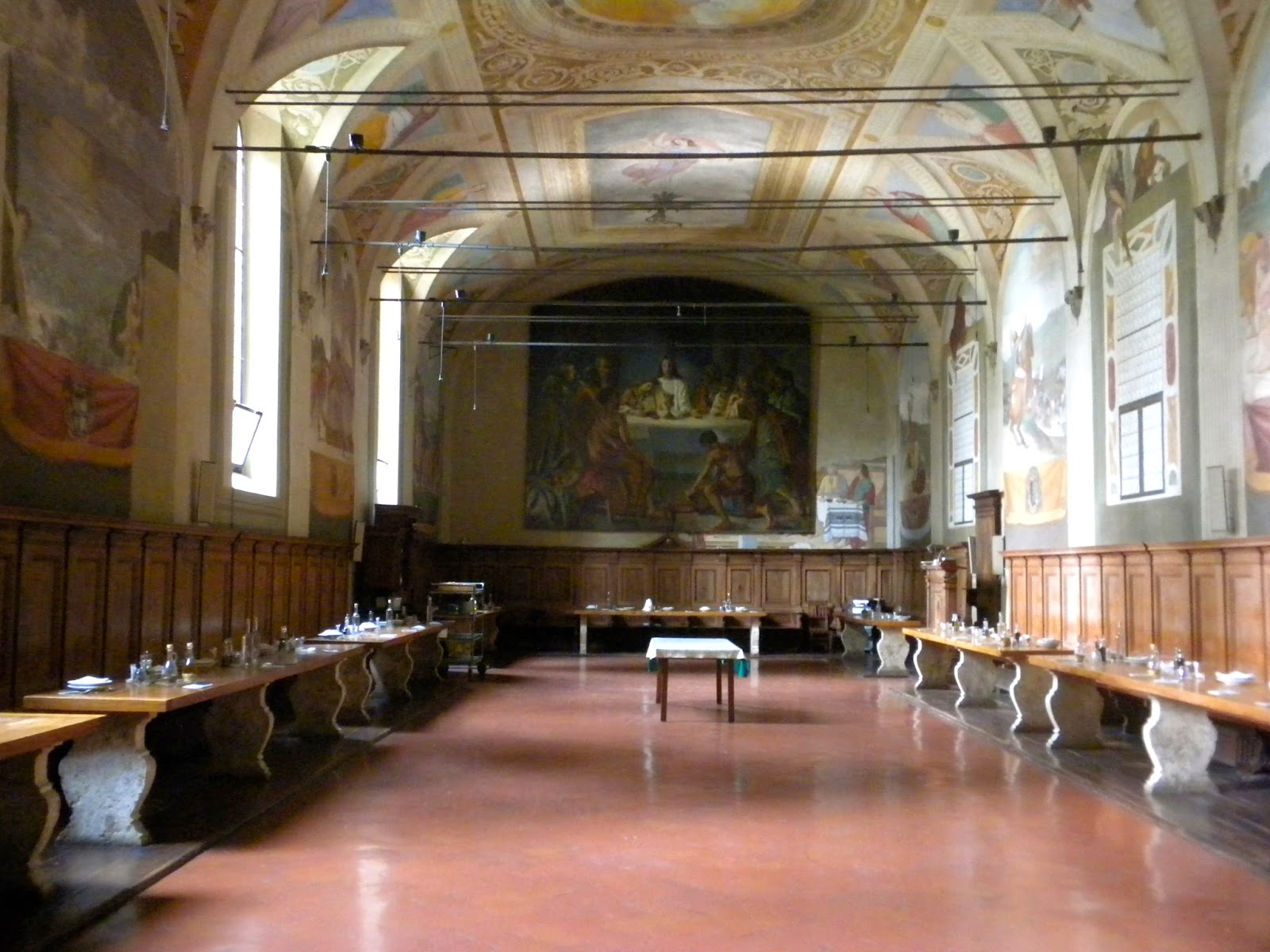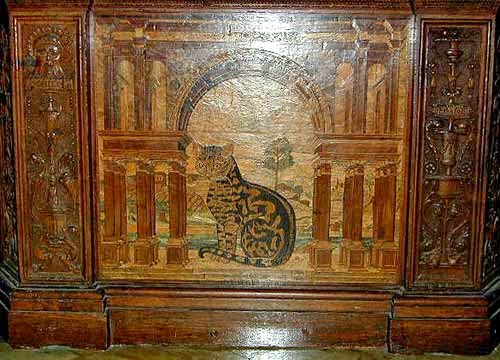The Two Abbeys
If you are travelling south of Siena, to the area known as the Crete Senesi (literally the Sienese Clays), and if you are interested in medieval and renaissance history, art and architecture, you will have to make a stop at the abbeys of Monte Oliveto Maggiore and Sant'Antimo, both founded by the Benedictines. The abbeys are interesting in themselves for several reasons, but the contrast between the two is also fascinating.
Monte Oliveto sprawls above a clay cliff on a hill south of Asciano. It is a considerable complex of brick buildings; bricks are the material of choice in this area: the clay they are made from is ubiquitous.
Sant'Antimo on the other hand sits cradled in a valley of the river Starcia, surrounded by olives and fields of wheat. It is south of Montalcino, not far from Monte Amiata. Sant'Antimo is partly in ruins and on a much smaller scale than its neighbour. It is built of local travertine and alabaster-onyx.
First to the larger abbey, the working monastery which produces wine, oil, liqueurs, pulses and spelt in its still extensive territory while the monks restore ancient manuscripts.
Monte Oliveto Maggiore
First to the larger abbey, the working monastery which produces wine, oil, liqueurs, pulses and spelt in its still extensive territory while the monks restore ancient manuscripts.
Monte Oliveto Maggiore
 |
| the clock and bell tower, endearingly, has caper plants growing on its roof |
 |
| the Great Cloister, completed between 1426 and '43; here is where the frescoes reside |
 |
| the Middle Cloister, built in the 15th century, from which one accesses the Refectory on the ground floor and the Library, Pharmacy and Museum on the first floor |
 |
| Capitular Hall (1498), now a Museum of religious art from the abbey |
 |
| the elegant former Pharmacy with precious 17th century ceramic vases containing medicinal herbs |
But here is the real treat; until now we have just been wandering idly through the abbey. The principal attraction of Monte Oliveto Maggiore is the cycle of frescoes which wind around the walls of the Great Cloister, the work of Luca Signorelli and Il Sodoma whose real name was Antonio Bazzi. Eight frescoes are by Signorelli (painted in 1497-98) who abandoned the monastery when called to work on the cathedral at Orvieto, while il Sodoma completed the cycle after 1505, painting 26 other lunettes (one of which was repainted by Riccio while another was painted by Bartolomeo Neroni). When you emerge into the Great Cloister from the dark church or the dim atrium with its ugly mosaic of Christ (the modern art at the monastery is not a patch on its renaissance ancestor), you will rejoice at the light and colour of the frescoes and their charming details, particularly from the animal world.
 |
| the predominant colours are yellow, green and terracotta contrasted with lapis lazuli |
 |
| this fresco by Signorelli,which depicts the saint removing a devil from on top of a rock, captivates with its solid, glowing, life-filled forms |
 |
| this, a detail from Il Sodoma's lunette depicting Benedict pardoning a monk for trying to flee the monastery; surely at least three of these faces are portraits |
 |
| I couldn't resist recording this testament to the builder's trade: 'How Benedict appears to two Monks and directs them to construct a Monastery' |
 |
| more striking portraits here in the lunette by Il Sodoma, 'How Benedict excommunicates two Nuns and absolves them when dead' |
 |
| I photographed this because of the delightful badgers (which appear to be pets), not realizing at the time that the young man with the badgers is in fact a self-portrait by Il Sodoma, Antonio Bazzi. |
 |
| Here is a better reproduction of the self-portrait. Note the direct (sardonic?) gaze, the fine hair. |
 |
| greater detail from the same lunette, unfortunately somewhat distorted by the angle |
 |
| charming background detail of bathers: who said the ancients couldn't swim! From Il Sodoma's 'How Benedict reattaches to a Cleaver the Handle which had fallen in the Lake' |
 | |
| exquisite cameo of a serving-woman from Signorelli's 'How Benedict says to the Monks when and where they ate, outside the Monastery.' A foretaste of Vermeer perhaps... |
 |
| the other serving woman, who has something of a Botticelli in her stance |
Even if there are only two dozen monks living at Monte Oliveto today, the abbey speaks volumes about the sheer power wielded by the Order and the Church which it represents.
Sant'Antimo says other things.
Sant'Antimo
 |
| timeless simplicity; the square tower is Lombard in design |
Interestingly,
the church seems modelled on medieval French and Lombard churches. The
bell tower, the ambulatory, a semi-circular open passage which curves behind the altar,
and the small chapel to the right of the nave, called the Carolingian
Chapel, testify to this.
Gradually over the following centuries the hold of the abbey weakened until in 1462 Pope Pius II (Piccolomini) suppressed the abbey; consequently the church and its annexations deteriorated. By the 19th century a farmer was living in the former bishop's apartments, using the church as a barn, and the cloisters as stables. In the 1870s it was restored by the Italian state and in 1992 was given new life by the Canons Regular of the Order of Prémontré, the Premonstratensians or White Canons who seem to make a living with their foresteria or guest rooms for retreats, as well as hosting summer camps in other structures nearby.
The painted wooden medieval crucifix hanging behind the altar is one of the church's most beautiful and precious works of art. Having been stored in the upstairs galleries for centuries, it was finally reinstated in 1972. The figure unusually unites the arts of sculpture and painting. Christ's eyes are closed, his body evokes quiet resignation, yet the cloth he wears about his waist is richly blue and gold.
A small crypt below the main altar once housed the remains of Sant'Antimo (martyred in the year 303). There is an early 15th century fresco above the altar/tomb.
Deliberate or not, the effect is emotionally/spiritually laden.
 |
| the stone at the base of this column has been smoothed by many hands over the centuries: the translucence of the alabaster-onyx seems to permeate the church |
 |
| The so-called groin vaults of the side naves; in Tuscany such a technique is otherwise found only in Pisa, while the central nave has a typical Tuscan wooden beamed ceiling. |
 |
| some of the gorgeous capitals with sheeps' heads and stylized plants: how modern they seem in their linear simplicity |
 |
| here, rams' heads |
 |
| monochrome frescoes of scenes from the life of Saint Benedict of Norcia - how they contrast with those of Monte Oliveto, but how splendid they are in their naivety |
 |
| the robes of the White Canons hanging in the Carolingian Chapel |
 |
| a scene from the past? |
 |
| a glimpse of what is left of the cloisters and other structures |
There is something about stone, light, silence and simplicity (a word oft-repeated in relation to Sant'Antimo), which communicate a sense of peace even the profane can appreciate.
53041 - ASCIANO (SI)
Tel. (+39) 0577.707611
Fax. (+39) 0577.707670
E-mail: abbazia@monteolivetomaggiore.it
Summer time:
Morning 09.15 - 12.00
Afternoon 15.15 - 17.00Winter time:
Morning 09.00 - 12.00
Afternoon 15.00 - 18.00On Sunday morning closing time is 12.30 Entrance to the Abbey is free.
Groups with their own guide are welcome to visit freely.To contact the Tour Guide of the Abbey:
Mr. Dino Benincasa (+39) 0577.718567(meal times)For any other information
call the Abbey directly tel: (+39) 0577 707611
- Weekdays - 07.00 hours
18.15 hours Vespers and conventual Holy Mass (Gregorian chant) - Sundays and Feasts - 11.00 hours conventual Holy Mass (Gregorian chant)
17.30 hours
- Saturday -
17.30 hours Vigil Mass
*Re the Benedictines treating themselves well: I have it from a reliable source that these days the fare in the monastery is modest and frugal and in no way resembles the more indulgent repasts for which the Benedictines were renowned.
Abbey of Sant'Antimo
Località Sant'Antimo
+39 0577 835659
Entry to the Church is free but the cloister, the capitular chamber, the community's residence, the library, the Carolingian chapel and crypt and galleries are not visitable.
However, for a guided visit ask the sacristan, Guido Burlando or reserve a visit calling 349 4796374 (evenings). Probably a tip is appreciated.
Visiting times for Church
Weekdays
Church opens - Matins 5.45
Lauds - 7.00
Terce - 9.00
Mass - 10.15-12.30
Sext - 12.45
Nones - 14.45
Visit of the Church - 15.00 - 18.30
Vespers - 19.00
Compline - 20.30 (21.00 Jul.+Aug.)
Church closes 21.00 (21.30 Jul.+Aug.)
Sundays and holidays*
Lauds - 7.30
Terce - 9.00
visit of the church - 9.15 - 10.45
Mass - 11.00
Sext - 12.45
Nones - 14.45
Vespers - 18.30
Compline - 20.30 (21.00 Jul.+Aug.)
Terce - 9.00
visit of the church - 9.15 - 10.45
Mass - 11.00
Sext - 12.45
Nones - 14.45
Vespers - 18.30
Compline - 20.30 (21.00 Jul.+Aug.)

























.jpg)


Such a beautifully appreciated and illustrated comparison of two out-of-the-way buildings, with stories and aspects that fascinate by the skill of the telling! A tour de force.
ReplyDelete